The following represent a virtual “who’s who” among Iowa legends in automotive sports and were inducted into the first Iowa Hall of Fame and Racing Museum, Inc., on Saturday, March 24, 2018, in Webster City, Iowa.
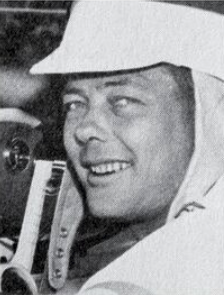 (Atlantic) – Beauchamp was a two-time IMCA Stock Car Champion, driving Chevrolets owned by the late Dale Swanson of Harlan, considered by many to have the first factory-backed automobile in the IMCA Stock Car series. Beauchamp began his racing career not many years after World War II, driving the souped-up cars that Swanson built. He raced mainly in Western Iowa, but later raced statewide. Driving a car owned by the Burdick family, Beauchamp raced in the first-ever Daytona 500 in 1959. He was originally declared winner of the of the race, but that was reversed four days later and the win given to Lee Petty, although Beauchamp and many observers said that Petty was a full lap behind at the finish. Beauchamp later promoted automobile races at such tracks as the Iowa State Fairgrounds in Des Moines and is credited with the re-building of the track in Audubon. Beauchamp was born March 23, 1923 in Harlan and passed away on April 17, 1981. Beauchamp was recognized by IMCA officials as one of the top drivers ever in the stock car series.
(Atlantic) – Beauchamp was a two-time IMCA Stock Car Champion, driving Chevrolets owned by the late Dale Swanson of Harlan, considered by many to have the first factory-backed automobile in the IMCA Stock Car series. Beauchamp began his racing career not many years after World War II, driving the souped-up cars that Swanson built. He raced mainly in Western Iowa, but later raced statewide. Driving a car owned by the Burdick family, Beauchamp raced in the first-ever Daytona 500 in 1959. He was originally declared winner of the of the race, but that was reversed four days later and the win given to Lee Petty, although Beauchamp and many observers said that Petty was a full lap behind at the finish. Beauchamp later promoted automobile races at such tracks as the Iowa State Fairgrounds in Des Moines and is credited with the re-building of the track in Audubon. Beauchamp was born March 23, 1923 in Harlan and passed away on April 17, 1981. Beauchamp was recognized by IMCA officials as one of the top drivers ever in the stock car series.
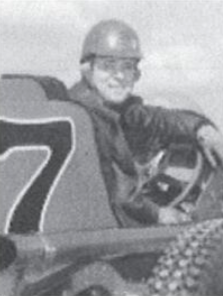 (LeMars) – Emory Collins settled in LeMars after he was brought to America from Canada by IMCA head John Sloan, son of IMCA founder J. Alex Sloan. Although he had been born in Iowa, Collins moved with his family to Canada when he was a youngster. Collins was an amateur boxer but turned to full-time racing with IMCA in the 1930’s. He was a perennial runner-up to legendary Gus Schrader but took over as IMCA champion after Schrader’s death in 1941. In their heyday of IMCA racing, Collins and Gus Schrader were the perennial kingpins of the sport all across the Midwest. He retired to LeMars after his career ended in the early 1950’s. Collins was born in Sibley in 1904. He died of a heart attack on June 2, 1982.
(LeMars) – Emory Collins settled in LeMars after he was brought to America from Canada by IMCA head John Sloan, son of IMCA founder J. Alex Sloan. Although he had been born in Iowa, Collins moved with his family to Canada when he was a youngster. Collins was an amateur boxer but turned to full-time racing with IMCA in the 1930’s. He was a perennial runner-up to legendary Gus Schrader but took over as IMCA champion after Schrader’s death in 1941. In their heyday of IMCA racing, Collins and Gus Schrader were the perennial kingpins of the sport all across the Midwest. He retired to LeMars after his career ended in the early 1950’s. Collins was born in Sibley in 1904. He died of a heart attack on June 2, 1982.
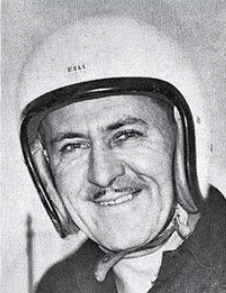 (Keokuk) – During his long career, Ernie Derr’s name became synonymous with the IMCA Stock Car Series. A 12-time series champion, Derr began racing the series in the early 1950s and campaigned Oldsmobiles and Pontiacs before forging a tough-to-beat partnership with Dodge. He drove the legendary Dodge Charger in each of his final seasons with the series and one season led the so-called “Keokuk Komets” to wins in every one of the 34 IMCA Stock Car races that season. He also won 11 races in the Automobile Racing Club of America (ARCA) Series and was a winner in the USAC Stock Car series as well. Derr’s brother-in-law Don White is also an inductee into our Hall of Fame. Derr retired from racing near the end of the IMCA Stock Car Series and lived his final days in Keokuk. Derr was 92 years old when he passed away. A World War II veteran, Derr was born October 29, 1921 and passed away on January 8, 2014.
(Keokuk) – During his long career, Ernie Derr’s name became synonymous with the IMCA Stock Car Series. A 12-time series champion, Derr began racing the series in the early 1950s and campaigned Oldsmobiles and Pontiacs before forging a tough-to-beat partnership with Dodge. He drove the legendary Dodge Charger in each of his final seasons with the series and one season led the so-called “Keokuk Komets” to wins in every one of the 34 IMCA Stock Car races that season. He also won 11 races in the Automobile Racing Club of America (ARCA) Series and was a winner in the USAC Stock Car series as well. Derr’s brother-in-law Don White is also an inductee into our Hall of Fame. Derr retired from racing near the end of the IMCA Stock Car Series and lived his final days in Keokuk. Derr was 92 years old when he passed away. A World War II veteran, Derr was born October 29, 1921 and passed away on January 8, 2014.
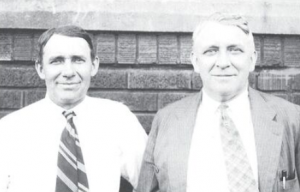 (Rockford) – The Duesenberg Brothers (Fred: 12/6/1876 to 7/25/1932) and August (12/12/1879 to 1/18/1955) founded Duesenberg Motors Co., Inc., on University Avenue in St. Paul, Minnesota in 1913 to build both engines and cars. They were self-taught engineers and built many experimental cars. Duesenberg cars were considered some of the best cars of the time and were built entirely by hand. In 1914, Eddie Rickenbacker drove a Duesenberg to finish in 10th place at the Indianapolis 500 and a Duesenberg won the race in 1924, 1925 and 1927. The company moved into aviation engine manufacturing when Col. R.C. Bolling and his commission acquired a license to produce the Bugatti U-16 for the U.S. Army Air Service. The end of World War I stopped this project before it could ever mature. In 1921, Duesenberg provided the pace car for the Indianapolis 500, driven by Fred Duesenberg. In 1923, the first Duesenbergs were built in Des Moines on Grand Avenue in what is now downtown Des Moines. Later, the brothers moved their car business to Indiana and the Duesenberg Automobile and Motors Company, Inc. was established in 1920. A number of restored Duesenberg automobiles are used annually during the Indianapolis 500 Parade.
(Rockford) – The Duesenberg Brothers (Fred: 12/6/1876 to 7/25/1932) and August (12/12/1879 to 1/18/1955) founded Duesenberg Motors Co., Inc., on University Avenue in St. Paul, Minnesota in 1913 to build both engines and cars. They were self-taught engineers and built many experimental cars. Duesenberg cars were considered some of the best cars of the time and were built entirely by hand. In 1914, Eddie Rickenbacker drove a Duesenberg to finish in 10th place at the Indianapolis 500 and a Duesenberg won the race in 1924, 1925 and 1927. The company moved into aviation engine manufacturing when Col. R.C. Bolling and his commission acquired a license to produce the Bugatti U-16 for the U.S. Army Air Service. The end of World War I stopped this project before it could ever mature. In 1921, Duesenberg provided the pace car for the Indianapolis 500, driven by Fred Duesenberg. In 1923, the first Duesenbergs were built in Des Moines on Grand Avenue in what is now downtown Des Moines. Later, the brothers moved their car business to Indiana and the Duesenberg Automobile and Motors Company, Inc. was established in 1920. A number of restored Duesenberg automobiles are used annually during the Indianapolis 500 Parade.
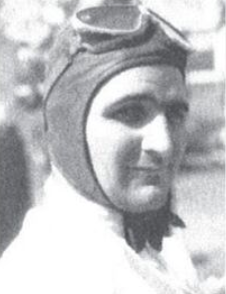 (Davenport) – He was a native of Kansas, born August 21, 1896, John Gerber became one of Iowa’s top IMCA “Big Car” drivers before World War II after moving his family to Iowa. Gerber was a force to be reckoned with in ferocious on-track battles with perennial IMCA champion, George “Gus” Schrader. He drove his first race in 1921 at St. Joseph, Mo. Later he helped design a successful bob-tail car, a Chevrolet powered by an Oldsmobile head engine, and Gerber outran a number of fields of cars, winning races from Cedar Rapids to Houston, Texas. Gerber and his wife, Rose, moved to Iowa in 1928 and he promised Rose he’d quit racing if they had children. He won his last race on Oct. 14, 1933 at Bel Aire, Maryland. He also manufactured parts and, after World War II, he began promoting races. He built a fifth-mile track at Centerville, Iowa, and also took over the reigns of the Mississippi Valley Fairgrounds in Davenport, promoting events that ranged from stocks to midgets. He promoted as many as eight races in a single week. Once retired from competition as a driver and owner, he wrote a book, compiled from the meticulous records he and his wife, Rose, kept through the years. He had two sons, Jim and John R. John Gerber passed away on April 11, 1979.
(Davenport) – He was a native of Kansas, born August 21, 1896, John Gerber became one of Iowa’s top IMCA “Big Car” drivers before World War II after moving his family to Iowa. Gerber was a force to be reckoned with in ferocious on-track battles with perennial IMCA champion, George “Gus” Schrader. He drove his first race in 1921 at St. Joseph, Mo. Later he helped design a successful bob-tail car, a Chevrolet powered by an Oldsmobile head engine, and Gerber outran a number of fields of cars, winning races from Cedar Rapids to Houston, Texas. Gerber and his wife, Rose, moved to Iowa in 1928 and he promised Rose he’d quit racing if they had children. He won his last race on Oct. 14, 1933 at Bel Aire, Maryland. He also manufactured parts and, after World War II, he began promoting races. He built a fifth-mile track at Centerville, Iowa, and also took over the reigns of the Mississippi Valley Fairgrounds in Davenport, promoting events that ranged from stocks to midgets. He promoted as many as eight races in a single week. Once retired from competition as a driver and owner, he wrote a book, compiled from the meticulous records he and his wife, Rose, kept through the years. He had two sons, Jim and John R. John Gerber passed away on April 11, 1979.
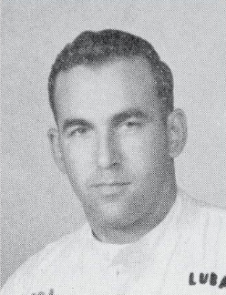 (Keokuk) – One of a long line of famous drivers who collectively became known as the “Keokuk Komets,” Dick Hutcherson was a two-time IMCA champion. He debuted a brand new 1963-1/2 Ford in 1963 and drove to championships in both 1963 and 1964 before heading south to drive on the NASCAR circuit. “Hutch” continued to win after moving to North Carolina. He won 14 NASCAR races from 1965 through 1967 when he retired from driving to devote his full-time attention to Hutcherson-Pagan Enterprises, a car builder/parts business catering to NASCAR clients. Later, he became owner of the business, along with his younger brother, Ron, also a former IMCA champion. Hutcherson passed away November 6, 2005, of a heart attack.
(Keokuk) – One of a long line of famous drivers who collectively became known as the “Keokuk Komets,” Dick Hutcherson was a two-time IMCA champion. He debuted a brand new 1963-1/2 Ford in 1963 and drove to championships in both 1963 and 1964 before heading south to drive on the NASCAR circuit. “Hutch” continued to win after moving to North Carolina. He won 14 NASCAR races from 1965 through 1967 when he retired from driving to devote his full-time attention to Hutcherson-Pagan Enterprises, a car builder/parts business catering to NASCAR clients. Later, he became owner of the business, along with his younger brother, Ron, also a former IMCA champion. Hutcherson passed away November 6, 2005, of a heart attack.
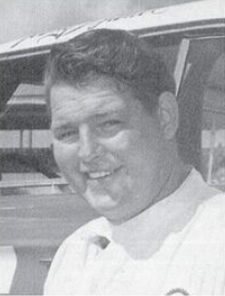 (Harlan) – Long-time car owner Dale Swanson of Harlan gave DeWayne “Tiny” Lund his start in automobile racing because Johnny Beauchamp refused to drive a “sissy” race car. That was way back in the early 1950’s when Beauchamp drove for Swanson in a car with no front fenders. When a race was scheduled for cars with fenders, Beauchamp refused to drive and Lund got his start, or so the story goes. That began a legendary career for Lund, who served in the Korean Conflict. He was a strong competitor in Chevrolets in the mid-1950’s IMCA Stock Car series but quit abruptly and moved to Cross, S.C., where he and his wife purchased a business catering to fishing. It seemed that Lund was always on the outside looking in when it came to a top ride in NASCAR’s elite series. That changed in 1963 at Daytona International Speedway. As usual, Lund was there and watched as NASCAR driver Marvin Panch was in a horrible crash while testing a sports car on the big track. Lund rushed to the scene and pulled Panch from his burning car. Unable to drive in that year’s 500, Panch told car owners Glenn and Leonard Wood that they should put Lund in the car that year. They did and the rest is history. Lund went on to win the race and remains the only Iowan ever to win the Daytona 500, considered the World Series of stock car racing. Lund won the 1973 NASCAR Grand National East Series championship and was the 1968, 1970 and 1971 NASCAR Grand American champion. He also won the Daytona Permatex 300 in 1970. Lund was a big man and known as a jokester, standing 6’4” tall and weighing 250 pounds. He began his racing career on motorcycles, turning to cars and a stellar career after serving his country in the Korean War. He would tragically lose his life in a NASCAR crash on August 17, 1975, at Talladega, Ala.
(Harlan) – Long-time car owner Dale Swanson of Harlan gave DeWayne “Tiny” Lund his start in automobile racing because Johnny Beauchamp refused to drive a “sissy” race car. That was way back in the early 1950’s when Beauchamp drove for Swanson in a car with no front fenders. When a race was scheduled for cars with fenders, Beauchamp refused to drive and Lund got his start, or so the story goes. That began a legendary career for Lund, who served in the Korean Conflict. He was a strong competitor in Chevrolets in the mid-1950’s IMCA Stock Car series but quit abruptly and moved to Cross, S.C., where he and his wife purchased a business catering to fishing. It seemed that Lund was always on the outside looking in when it came to a top ride in NASCAR’s elite series. That changed in 1963 at Daytona International Speedway. As usual, Lund was there and watched as NASCAR driver Marvin Panch was in a horrible crash while testing a sports car on the big track. Lund rushed to the scene and pulled Panch from his burning car. Unable to drive in that year’s 500, Panch told car owners Glenn and Leonard Wood that they should put Lund in the car that year. They did and the rest is history. Lund went on to win the race and remains the only Iowan ever to win the Daytona 500, considered the World Series of stock car racing. Lund won the 1973 NASCAR Grand National East Series championship and was the 1968, 1970 and 1971 NASCAR Grand American champion. He also won the Daytona Permatex 300 in 1970. Lund was a big man and known as a jokester, standing 6’4” tall and weighing 250 pounds. He began his racing career on motorcycles, turning to cars and a stellar career after serving his country in the Korean War. He would tragically lose his life in a NASCAR crash on August 17, 1975, at Talladega, Ala.
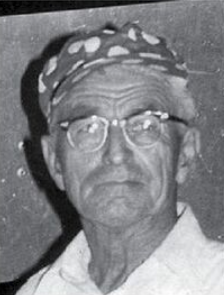 (Des Moines) – Marion Robinson’s long career in auto racing actually began in his hometown of St. Joseph, Mo., where his family lived next door to a race shop. It was there Robinson began working in racing, first as a welder on Model T race cars. He moved with his family to Des Moines during World War II and it was in Des Moines that Robinson’s long Iowa career began. He began promoting in the early 1950’s at Pioneer (initially Kessell) Raceway on Southeast 14th Street in Des Moines. He promoted races at Newton, Stuart, Chariton, Bloomfield, Mason City, Mount Ayr and Dayton, but he’s best known for his work at Knoxville Raceway, a track he began promoting in 1956. Under his direction, the jalopies at Knoxville quickly evolved into Super Modifieds and by 1959 he promoted the Midwest Invitational for super-modifieds at Knoxville. By 1961, the event had become the Knoxville Nationals which has grown into the most prestigious sprint car race in the world. He convinced the Marion County Fair Board to put up a $5,000 purse for that first annual event in 1961. During his long career, Robinson promoted stocks, modifieds, super-modifieds, late models, sportsman and sprint cars. Robinson is called the “Father of the Knoxville Nationals”. He was inducted into the National Sprint Car Hall of Fame in 1991 and the Knoxville Raceway Hall of Fame in 1979. He was born on March 15, 1907 and passed away December 14, 1990.
(Des Moines) – Marion Robinson’s long career in auto racing actually began in his hometown of St. Joseph, Mo., where his family lived next door to a race shop. It was there Robinson began working in racing, first as a welder on Model T race cars. He moved with his family to Des Moines during World War II and it was in Des Moines that Robinson’s long Iowa career began. He began promoting in the early 1950’s at Pioneer (initially Kessell) Raceway on Southeast 14th Street in Des Moines. He promoted races at Newton, Stuart, Chariton, Bloomfield, Mason City, Mount Ayr and Dayton, but he’s best known for his work at Knoxville Raceway, a track he began promoting in 1956. Under his direction, the jalopies at Knoxville quickly evolved into Super Modifieds and by 1959 he promoted the Midwest Invitational for super-modifieds at Knoxville. By 1961, the event had become the Knoxville Nationals which has grown into the most prestigious sprint car race in the world. He convinced the Marion County Fair Board to put up a $5,000 purse for that first annual event in 1961. During his long career, Robinson promoted stocks, modifieds, super-modifieds, late models, sportsman and sprint cars. Robinson is called the “Father of the Knoxville Nationals”. He was inducted into the National Sprint Car Hall of Fame in 1991 and the Knoxville Raceway Hall of Fame in 1979. He was born on March 15, 1907 and passed away December 14, 1990.
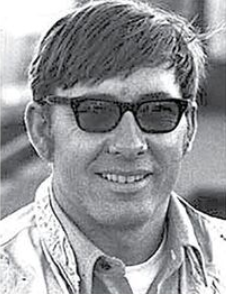 (Waterloo) – One night at West Liberty Raceway, the feature lineup had just been posted. Drivers took a glance and moved away, but Ed Sanger stood at the board and looked at it for several minutes. Asked why he explained that he was studying the lineup and, in his mind, was going over the tendencies of each driver at the start. He was imagining how he could quickly move to the front in the first five laps, advancing from his seventh starting position. Details like that are just one of the reasons Sanger went from being “Cap’n Crunch” when he first started racing to “Fast Eddie” by the time vision problems finally forced him to hang up his helmet. Before he retired, Sanger was known as one of the top late model drivers ever to buckle up, becoming a perennial winner not only in his native Iowa, but also across the country. He even drove the Helen Rae Special Chevrolet in a NASCAR Winston Cup event, but he was far more at home on dirt tracks. Sanger left his hometown in Northeast Iowa and moved to Waterloo where he also began building cars in the early 1970s. The Sanger Chassis was favored by many in Iowa and Sanger often found himself racing against cars he’d built at his shop in Waterloo. During his career, Sanger won more than 600 feature races at more than 30 different tracks. Sanger won the Yankee Dirt Track Classic in 1983, he was the World 100 winner in 1974 at Eldora Speedway in Rossburg, Ohio, the Triple Crown Dirt Championship in 1971, the JC Challenge Cup in both 1975 and 1976, the Silver Dollar 1000 at Proctor, Minnesota, the Miller 100 at Hawkeye Downs, the Boone Grand Nationals on three times, the Iron Man Invitational at Hibbing, Minnesota, also three times, the South Dakota Invitational, the Missouri State Championship, the North Dakota State Championship, the Wisconsin NGK Invitational and the Quad City 100, to name only a few of his big wins. In 1976, Sanger won 43 feature races, ranking as America’s winningest driver that year. He raced at tracks from Canada to Florida and most places between.
(Waterloo) – One night at West Liberty Raceway, the feature lineup had just been posted. Drivers took a glance and moved away, but Ed Sanger stood at the board and looked at it for several minutes. Asked why he explained that he was studying the lineup and, in his mind, was going over the tendencies of each driver at the start. He was imagining how he could quickly move to the front in the first five laps, advancing from his seventh starting position. Details like that are just one of the reasons Sanger went from being “Cap’n Crunch” when he first started racing to “Fast Eddie” by the time vision problems finally forced him to hang up his helmet. Before he retired, Sanger was known as one of the top late model drivers ever to buckle up, becoming a perennial winner not only in his native Iowa, but also across the country. He even drove the Helen Rae Special Chevrolet in a NASCAR Winston Cup event, but he was far more at home on dirt tracks. Sanger left his hometown in Northeast Iowa and moved to Waterloo where he also began building cars in the early 1970s. The Sanger Chassis was favored by many in Iowa and Sanger often found himself racing against cars he’d built at his shop in Waterloo. During his career, Sanger won more than 600 feature races at more than 30 different tracks. Sanger won the Yankee Dirt Track Classic in 1983, he was the World 100 winner in 1974 at Eldora Speedway in Rossburg, Ohio, the Triple Crown Dirt Championship in 1971, the JC Challenge Cup in both 1975 and 1976, the Silver Dollar 1000 at Proctor, Minnesota, the Miller 100 at Hawkeye Downs, the Boone Grand Nationals on three times, the Iron Man Invitational at Hibbing, Minnesota, also three times, the South Dakota Invitational, the Missouri State Championship, the North Dakota State Championship, the Wisconsin NGK Invitational and the Quad City 100, to name only a few of his big wins. In 1976, Sanger won 43 feature races, ranking as America’s winningest driver that year. He raced at tracks from Canada to Florida and most places between.
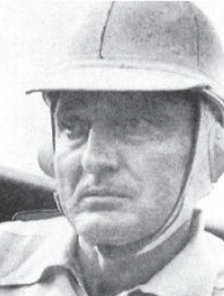 (Newhall) – Widely recognized as the greatest Iowa driver of all time, George “Gus” Schrader was a perennial IMCA champion before his untimely death on October 22, 1941 during an IMCA Big Car race at the Louisiana State Fairgrounds in Shreveport. In 1933, he began his domination of IMCA racing when he snatched the championship away from legendary Sig Haugdahl, who’d won five IMCA titles. The following year, 1934, began the strong head-to-head competition for IMCA dominance with another Iowan, Emory Collins. During the mid-1930’s, Schrader drove cars built by the legendary Harry Miller, whose cars cost a then-whopping $15,000 each. Schrader won IMCA titles in 1934, 1935, 1936 and 1937, earning the title “King of the Dirt Tracks.” He won championships again in 1939, 1940 and 1941, which proved a fateful year. On October 22, 1941, Schrader’s car rode over the wheel of Jimmy Wilburn’s car and crashed through a wooden fence at the Louisiana State Fairgrounds in Shreveport. Schrader was mortally injured and died in a Shreveport hospital. He was named to the Des Moines Register Hall of Fame, the IMCA Hall of Fame and the National Sprint Car Hall of Fame.
(Newhall) – Widely recognized as the greatest Iowa driver of all time, George “Gus” Schrader was a perennial IMCA champion before his untimely death on October 22, 1941 during an IMCA Big Car race at the Louisiana State Fairgrounds in Shreveport. In 1933, he began his domination of IMCA racing when he snatched the championship away from legendary Sig Haugdahl, who’d won five IMCA titles. The following year, 1934, began the strong head-to-head competition for IMCA dominance with another Iowan, Emory Collins. During the mid-1930’s, Schrader drove cars built by the legendary Harry Miller, whose cars cost a then-whopping $15,000 each. Schrader won IMCA titles in 1934, 1935, 1936 and 1937, earning the title “King of the Dirt Tracks.” He won championships again in 1939, 1940 and 1941, which proved a fateful year. On October 22, 1941, Schrader’s car rode over the wheel of Jimmy Wilburn’s car and crashed through a wooden fence at the Louisiana State Fairgrounds in Shreveport. Schrader was mortally injured and died in a Shreveport hospital. He was named to the Des Moines Register Hall of Fame, the IMCA Hall of Fame and the National Sprint Car Hall of Fame.
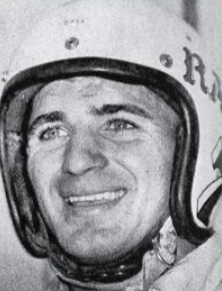 (Keokuk) – Born April 6, 1934, Ramo Stott became an Iowa racing legend after moving from his native Kahoka, Mo., across the Iowa state line and settling in Keokuk. There, Stott became one of the so-called “Keokuk Komets,” a group of drivers from that small community nestled in the far Southeast corner of Iowa. Stott began his racing career at the now-gone Keokuk Speedway and soon became a frequent winner. Stott entered IMCA Stock Car competition in the 1950’s and was a perennial front-runner. He became known as IMCA’s “uncrowned champion,” because he was never the point champion, but several times the runner-up in season competition. He eventually left IMCA for Automobile Racing Club of America (ARCA) events, where he became a three-time champion in the 1970’s. When several well-known NASCAR drivers boycotted the first-ever race at Talladega Superspeedway, Stott was in the field and ran among leaders all day, finishing third in that historic race. Stott remains the only Iowan ever to win the pole position for the Daytona 500 when he started up front in the 1976 race, driving a Chevrolet. Stott excelled in IMCA, NASCAR, ARCA and USAC Stock Car racing.
(Keokuk) – Born April 6, 1934, Ramo Stott became an Iowa racing legend after moving from his native Kahoka, Mo., across the Iowa state line and settling in Keokuk. There, Stott became one of the so-called “Keokuk Komets,” a group of drivers from that small community nestled in the far Southeast corner of Iowa. Stott began his racing career at the now-gone Keokuk Speedway and soon became a frequent winner. Stott entered IMCA Stock Car competition in the 1950’s and was a perennial front-runner. He became known as IMCA’s “uncrowned champion,” because he was never the point champion, but several times the runner-up in season competition. He eventually left IMCA for Automobile Racing Club of America (ARCA) events, where he became a three-time champion in the 1970’s. When several well-known NASCAR drivers boycotted the first-ever race at Talladega Superspeedway, Stott was in the field and ran among leaders all day, finishing third in that historic race. Stott remains the only Iowan ever to win the pole position for the Daytona 500 when he started up front in the 1976 race, driving a Chevrolet. Stott excelled in IMCA, NASCAR, ARCA and USAC Stock Car racing.
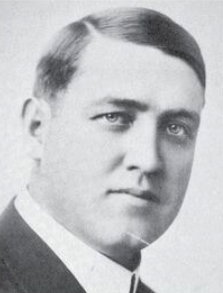 (Minneapolis, Minn.) – John Alexander Sloan is considered by many to be the father of automobile racing in Iowa and the Midwest. Although a number of automobile racing events had been held in Iowa before Sloan spearheaded birth of the International Motor Contest Association, it was Sloan who spurred growth of the sport in the state. Not until IMCA had been born was automobile racing so readily available to speed-starved Iowans. Although he was a native of Pittsburgh, Pa., and was a football star at Ohio Wesleyan University, his involvement in the fledgling sport of automobile racing began when he was a sportswriter in St. Paul, Minn. He first promoted races at the Minnesota State Fair in 1905 and followed that with promotion of auto events nationwide with driving stars like Louis Chevrolet, Earl Kizer, Ralph DePalma, Eddie Rickenbacker and Barney Oldfield. He was instrumental in formation of IMCA in March of 1915. The first race of the new association was held at the Michigan State Fairgrounds in Detroit in 1915 and resulted in lifetime bans by the AAA, then the only recognized auto racing body in the U.S. In 1922, Sloan and driver Sig Haugdahl, a Norwegian immigrant who’d settled with his family in Albert Lea, Minn., 10 miles north of the Iowa border, set a world speed record as Haugdahl drove the Wisconsin Special to more than 180 miles per hour at Daytona Beach, Fla. The speed record, although far exceeding the record at the time, was never officially recognized by AAA. The record stood for a decade. Sloan promoted 137 races in 22 states and Canada by 1937, when he died. That was more races than all other promoters in the U.S. combined.
(Minneapolis, Minn.) – John Alexander Sloan is considered by many to be the father of automobile racing in Iowa and the Midwest. Although a number of automobile racing events had been held in Iowa before Sloan spearheaded birth of the International Motor Contest Association, it was Sloan who spurred growth of the sport in the state. Not until IMCA had been born was automobile racing so readily available to speed-starved Iowans. Although he was a native of Pittsburgh, Pa., and was a football star at Ohio Wesleyan University, his involvement in the fledgling sport of automobile racing began when he was a sportswriter in St. Paul, Minn. He first promoted races at the Minnesota State Fair in 1905 and followed that with promotion of auto events nationwide with driving stars like Louis Chevrolet, Earl Kizer, Ralph DePalma, Eddie Rickenbacker and Barney Oldfield. He was instrumental in formation of IMCA in March of 1915. The first race of the new association was held at the Michigan State Fairgrounds in Detroit in 1915 and resulted in lifetime bans by the AAA, then the only recognized auto racing body in the U.S. In 1922, Sloan and driver Sig Haugdahl, a Norwegian immigrant who’d settled with his family in Albert Lea, Minn., 10 miles north of the Iowa border, set a world speed record as Haugdahl drove the Wisconsin Special to more than 180 miles per hour at Daytona Beach, Fla. The speed record, although far exceeding the record at the time, was never officially recognized by AAA. The record stood for a decade. Sloan promoted 137 races in 22 states and Canada by 1937, when he died. That was more races than all other promoters in the U.S. combined.
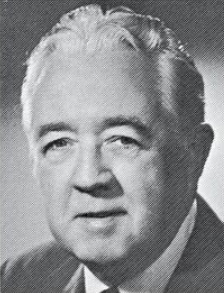 (Chicago, Ill./Tampa, Fla.) – Al Sweeney is another non-Iowan who is fittingly enshrined in the Iowa Racing Hall of Fame. A native of Chicago and a life-long showman, Sweeney became an early protégé of J. Alex Sloan and continued his work in IMCA racing with John Sloan and Aut Swenson, more famous for his automobile thrill shows. After J. Alex passed away in 1937, Sweeney took over the auto racing tradition. With Gaylord White, Sweeney formed National Speedways, Inc., in 1940 in Chicago. With Sweeney at the helm, NSI began promoting IMCA races across the Midwest and beyond. The first “star” of NSI racing was legendary Emory Collins of LeMars, Iowa. His first NSI event was at Sioux Falls, S.D. Through the years, Sweeney and his NSI group promoted countless races in Iowa at the State Fair in Des Moines and at other county fairs around the state. He promoted state fair races in Iowa, Missouri, Kansas, Florida and Louisiana, most of them the “big car” events popular before stock car racing began following World War II. In early days, Sweeney was both promoter and starter, becoming widely known for standing on the front stretch with his flags, waving the green flag at the last possible minute before scampering out of the way of the speeding field of cars. Sweeney was known for his generous “helping hand” to drivers in need. He’d often reach into his own pocket, for example, to give gas money to out-of-state competitors who needed it to get home. After a serious crash in the 1970’s in a stock car race on the mile track at the Missouri State Fairgrounds in Sedalia, a driver from Minnesota was surprised to receive a check for $400 in the mail about a week after the crash had destroyed his car. “This might help a little,” Sweeney wrote in the attached note for the surprised driver. He was one of the first promoters to use the inverted start for IMCA Big Car races. He was inducted into the IMCA Hall of Fame in 1971. He passed away about 35 years ago while on his way to visit his hospitalized wife and life’s partner, Bereniece, whom he affectionately called “Brunch.” Brunch died shortly after Al passed away.
(Chicago, Ill./Tampa, Fla.) – Al Sweeney is another non-Iowan who is fittingly enshrined in the Iowa Racing Hall of Fame. A native of Chicago and a life-long showman, Sweeney became an early protégé of J. Alex Sloan and continued his work in IMCA racing with John Sloan and Aut Swenson, more famous for his automobile thrill shows. After J. Alex passed away in 1937, Sweeney took over the auto racing tradition. With Gaylord White, Sweeney formed National Speedways, Inc., in 1940 in Chicago. With Sweeney at the helm, NSI began promoting IMCA races across the Midwest and beyond. The first “star” of NSI racing was legendary Emory Collins of LeMars, Iowa. His first NSI event was at Sioux Falls, S.D. Through the years, Sweeney and his NSI group promoted countless races in Iowa at the State Fair in Des Moines and at other county fairs around the state. He promoted state fair races in Iowa, Missouri, Kansas, Florida and Louisiana, most of them the “big car” events popular before stock car racing began following World War II. In early days, Sweeney was both promoter and starter, becoming widely known for standing on the front stretch with his flags, waving the green flag at the last possible minute before scampering out of the way of the speeding field of cars. Sweeney was known for his generous “helping hand” to drivers in need. He’d often reach into his own pocket, for example, to give gas money to out-of-state competitors who needed it to get home. After a serious crash in the 1970’s in a stock car race on the mile track at the Missouri State Fairgrounds in Sedalia, a driver from Minnesota was surprised to receive a check for $400 in the mail about a week after the crash had destroyed his car. “This might help a little,” Sweeney wrote in the attached note for the surprised driver. He was one of the first promoters to use the inverted start for IMCA Big Car races. He was inducted into the IMCA Hall of Fame in 1971. He passed away about 35 years ago while on his way to visit his hospitalized wife and life’s partner, Bereniece, whom he affectionately called “Brunch.” Brunch died shortly after Al passed away.
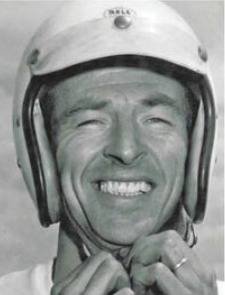 (Keokuk) – Don White of Keokuk took his act on the road to become a star in the United States Auto Club Stock Car series. He began his career in 1949 – first year of the IMCA Stock Car Series – at Hawkeye Downs in Cedar Rapids. He was running second when sidelined with mechanical failure. He went on to win three IMCA Stock Car championship, winning back-to-back titles in 1954 and 1955 before winning his third title in 1958 in a Ford. By that time, White had won on every track on the IMCA circuit. White’s biggest competitor was his brother-in-law Ernie Derr. After the ’58 season, White turned to United States Auto Club (USAC) Stock Car action and he quickly became that series’ winningest driver. He won USAC championship twice during the 1960’s. He also competed in 24 NASCAR Cup Series events between 1954 and 1972 and had seven top-five finishes in that series. His final race was August 28, 1983 in a USAC race at the famed Milwaukee Mile, a track he considered his favorite. He ended his USAC career with the most victories in stock car series history. He won 53 USAC races before the series ended, 12 more than legendary A.J. Foyt. He won “14 or 15” events at Milwaukee, more than any other driver in any series. Born June 24, 1926, White passed away on April 29, 2016 at 89 years of age.
(Keokuk) – Don White of Keokuk took his act on the road to become a star in the United States Auto Club Stock Car series. He began his career in 1949 – first year of the IMCA Stock Car Series – at Hawkeye Downs in Cedar Rapids. He was running second when sidelined with mechanical failure. He went on to win three IMCA Stock Car championship, winning back-to-back titles in 1954 and 1955 before winning his third title in 1958 in a Ford. By that time, White had won on every track on the IMCA circuit. White’s biggest competitor was his brother-in-law Ernie Derr. After the ’58 season, White turned to United States Auto Club (USAC) Stock Car action and he quickly became that series’ winningest driver. He won USAC championship twice during the 1960’s. He also competed in 24 NASCAR Cup Series events between 1954 and 1972 and had seven top-five finishes in that series. His final race was August 28, 1983 in a USAC race at the famed Milwaukee Mile, a track he considered his favorite. He ended his USAC career with the most victories in stock car series history. He won 53 USAC races before the series ended, 12 more than legendary A.J. Foyt. He won “14 or 15” events at Milwaukee, more than any other driver in any series. Born June 24, 1926, White passed away on April 29, 2016 at 89 years of age.
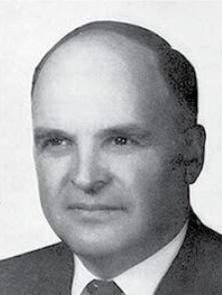 (New Brighton, Minn.) – Frank Winkley was just 61 years old when he lost his life in a highway accident in his native Minnesota. Winkley famously once said, “I have only one prayer. That when I go, I don’t go in bed. I want to be behind the wheel of a fast-moving car. That’s how I’ve lived.” He got his wish when his souped-up car went out of control on a highway; he was en route to Madison, Minn., where he promoted annual stock car races during the county fair. Winkley operated Auto Racing, Inc., one of two sanctioning bodies to promote and run IMCA Sprint Car and Stock Car series races (the other was Al Sweeney’s National Speedways, Inc.) and the two were often at war when it came to protecting drivers in their respective groups. Often, Winkley would pay one of “his” drivers purse money to keep him away from a Sweeney-promoted race and Sweeney did the same. Despite that uneasy relationship, IMCA racing’s popularity soared under Winkley’s leadership. He was an innovator, as well as a promoter. He built a portable lighting system that he carried on a truck from track to track to promote night races at facilities without lights. In fact, one of the first such races was an IMCA Stock Car race at Hawkeye Downs in Cedar Rapids. Once, he promoted a race in North Dakota, under the lights, then hauled his system to Iowa for a race the following night. Winkley’s race team was a family affair. In fact, his wife Verna took over operation of the racing operation after her husband’s untimely death and continued to promote IMCA events, and to run weekly events at Hawkeye Downs, for a year after her husband’s fatal highway crash. In addition to promoting races, Winkley was a motorcycle daredevil in his younger days. In fact, Winkley is credited with originating the IMCA Stock Car series. After a stunt show in California, Winkley was headed cross country to another such event when he saw a poster announcing a “stock car” race at a small track in New Mexico. That spurred the idea and IMCA began sanctioning races in 1949. Winkley, driving a Frazier car, and his friend Tilman Huset of Sioux Falls, S.D., in a Studebaker, were two participants in the first Winkley-promoted stock car race.
(New Brighton, Minn.) – Frank Winkley was just 61 years old when he lost his life in a highway accident in his native Minnesota. Winkley famously once said, “I have only one prayer. That when I go, I don’t go in bed. I want to be behind the wheel of a fast-moving car. That’s how I’ve lived.” He got his wish when his souped-up car went out of control on a highway; he was en route to Madison, Minn., where he promoted annual stock car races during the county fair. Winkley operated Auto Racing, Inc., one of two sanctioning bodies to promote and run IMCA Sprint Car and Stock Car series races (the other was Al Sweeney’s National Speedways, Inc.) and the two were often at war when it came to protecting drivers in their respective groups. Often, Winkley would pay one of “his” drivers purse money to keep him away from a Sweeney-promoted race and Sweeney did the same. Despite that uneasy relationship, IMCA racing’s popularity soared under Winkley’s leadership. He was an innovator, as well as a promoter. He built a portable lighting system that he carried on a truck from track to track to promote night races at facilities without lights. In fact, one of the first such races was an IMCA Stock Car race at Hawkeye Downs in Cedar Rapids. Once, he promoted a race in North Dakota, under the lights, then hauled his system to Iowa for a race the following night. Winkley’s race team was a family affair. In fact, his wife Verna took over operation of the racing operation after her husband’s untimely death and continued to promote IMCA events, and to run weekly events at Hawkeye Downs, for a year after her husband’s fatal highway crash. In addition to promoting races, Winkley was a motorcycle daredevil in his younger days. In fact, Winkley is credited with originating the IMCA Stock Car series. After a stunt show in California, Winkley was headed cross country to another such event when he saw a poster announcing a “stock car” race at a small track in New Mexico. That spurred the idea and IMCA began sanctioning races in 1949. Winkley, driving a Frazier car, and his friend Tilman Huset of Sioux Falls, S.D., in a Studebaker, were two participants in the first Winkley-promoted stock car race.